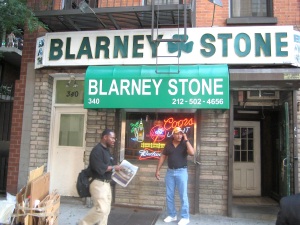Chalk it up to the young city’s festive, indulgent vibe—or the fact that the drinking water wasn’t always safe to consume.
But colonial-era New York supported lots of bars. One was the Bull’s Head Tavern, built around 1760 near Canal Street and the Bowery—at the time, the outskirts of the city.
It was a rough-and-tumble place that catered to the livestock industry nearby: butchers, cattle men, and drovers (the guys who marched animals down to this district of stockyards and slaughterhouses).
 “Out-of-town drovers and city butchers congregated in the smoky, low-ceilinged rooms of the Bull’s Head Tavern, which stood just below modern Canal Street amid a jumble of stables, cattle pens, and slaughterhouses,” states Gotham: A History of New York City to 1898.
“Out-of-town drovers and city butchers congregated in the smoky, low-ceilinged rooms of the Bull’s Head Tavern, which stood just below modern Canal Street amid a jumble of stables, cattle pens, and slaughterhouses,” states Gotham: A History of New York City to 1898.
Besides boozing, gambling, and carousing, Bull’s Head patrons enjoyed another attraction: bear-baiting, a not uncommon colonial pastime.
 There was a celebrity patron too: George Washington. He and his staff met here on Evacuation Day in 1783, after British troops left the city.
There was a celebrity patron too: George Washington. He and his staff met here on Evacuation Day in 1783, after British troops left the city.
The Bull’s Head thrived here as late as the 1820s, until the neighborhood became more genteel and residents drove the tavern and the slaughterhouse industry uptown—to about today’s Third Avenue and 24th Street.
[Bottom sketch: NYPL Digital Collection]









